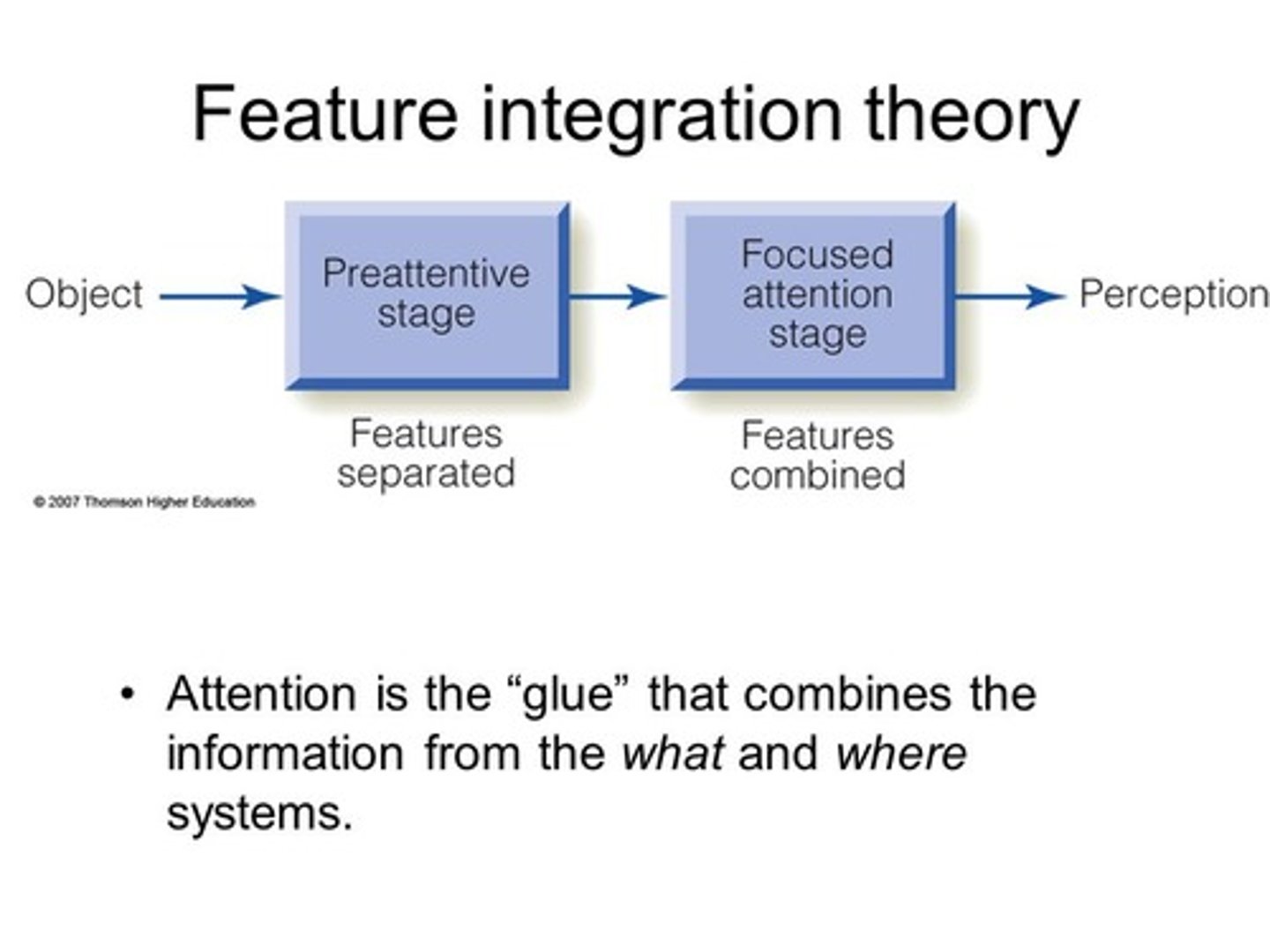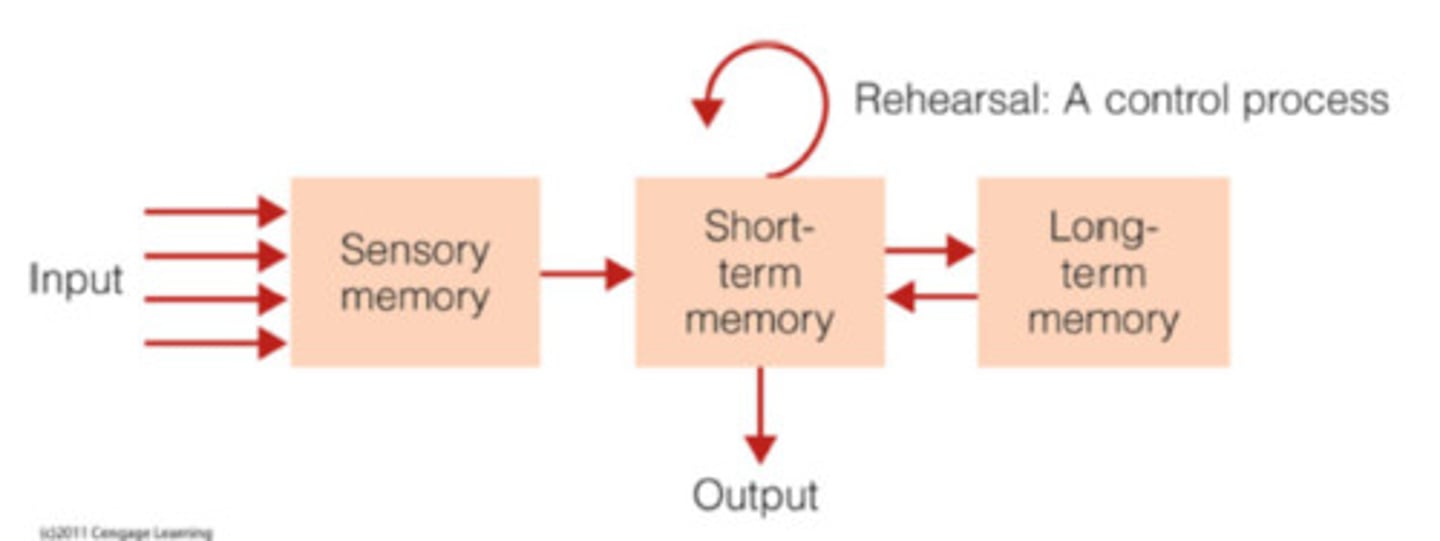Cognitive Psychology Exam 2 Ohio University Dr. Gennadiy Gurariy
1/82
There's no tags or description
Looks like no tags are added yet.
Name | Mastery | Learn | Test | Matching | Spaced |
|---|
No study sessions yet.
83 Terms
attention
the ability to focus on specific stimuli or locations
Selective attention
attending to one thing while ignoring others
Distractors
Stimulus that competes for attention
Divided attention
concentrating on more than one activity at the same time
Attention capture
a rapid shifting of attention usually caused by a stimulus such as a loud noise, bright light, or sudden movement
Visual scanning
A shift of attention across a visual display or image
Dichotic listening study
assesses the ability to process and selectively attend to auditory information presented to both ears
Broadbent's Attention Model
Sensory memory to filter to detector to memory

Sensory memory
Captures all incoming information for a brief moment before passing it into the filter
Filter
Selects the attended message based on physical characteristics and filters out other messages
Detector
Processes higher-level characteristics of the attended message
Memory
the ability to store and retrieve information over time
Short term memory
activated memory that holds a few items briefly, such as the seven digits of a phone number while dialing, before the information is stored or forgotten
Long term memory
the relatively permanent and limitless storehouse of the memory system. Includes knowledge, skills, and experiences.
attenuation model of attention
Anne Treisman's model of selective attention that proposes that selection occurs in two stages. In the first stage, an attenuator analyzes the incoming message and lets through the attended message—and also the unattended message, but at a lower (attenuated) strength.

attenuator
analyzes incoming messages in terms of physical characteristics, language, and meaning
Dictionary unit
contains words, stored in memory, each of which has a threshold for being activated
Late selection findings
Final processing does not occur until after info has been analyzed for meaning
Load theory
The higher the perceptual load, the more difficult cognitive/executive tasks. Our ability to attenuate distractors depends on the load.
Stroop task
harder to name ink color of words than to say word names
Overt attention
shifting attention from one place to another by moving the eyes
Saccades
Rapid voluntary movements of the eyes.
Fixation
Pauses
Bottom-up Determinants of Eye Movement
Stimulus salience: areas that stand out and capture attention
Top-down determinants of eye movements
~Scene schema: knowledge about what is contained in typical scenes. A scene schema helps guide fixation from one area of a scene to another.
~ Eye movements are determined by task & eye movements proceeded motor actions by a fraction of a second
Attention location
frontal and parietal lobes
attention to objects
1. attention can enhance our response to objects
2. when attention is directed to one place on an object, the enhancing effect of that attention spreads to other places on the object
Attention affects perception
attended objects are perceived to be bigger and faster, and to be more richly colored and have better contrast than non-attended objects
Attention affects physiology
Attention strengthens neural responses to attended stimuli and weakens responses to others
divided attention
concentrating on more than one activity at the same time
inattention
lack of attention
inattentional blindness
failing to see visible objects when our attention is directed elsewhere
Inattentional deafness
failing to hear an auditory message when attention is elsewhere
Change blindness
failing to notice changes in the environment
Binding
the process by which features such as color, form, motion, and location are combined to create our perception of a coherent object
Binding problem
how features are linked together so that we see unified objects in our visual world rather than free-floating or miscombined features
Feature integration theory
the idea that focused attention is not required to detect the individual features that comprise a stimulus, but is required to bind those individual features together

Attention networks
dorsal and ventral attention networks
Dorsal attention network
A network that controls attention based on top-down processing.
Ventral attention network
A network that controls attention based on stimulus salience.
Attention synchronization
How easy it is to transfer activity flows along brain pathways
Modal model of memory
sensory memory, short-term memory, long-term memory

Sensory memory
initial stage that holds all incoming information for seconds or fractions of a second
Sperling Studies of Sensory Memory
Participants were briefly shown a grid of letters and then asked to recall as many as possible (whole report). In the "partial report" condition, a tone sounded immediately after the display, indicating which row of letters to report. peformance decreases rapidly
Digit span
The number of digits a person can remember. Digit span is used as a measure of the capacity of short-term memory.
Change detection approach
STM capacity is approx. 4 items
Chunking
organizing items into familiar, manageable units; often occurs automatically
Working memory
A newer understanding of short-term memory that involves conscious, active processing of incoming auditory and visual-spatial information, and of information retrieved from long-term memory.
phonological loop
the part of working memory that holds and processes verbal and auditory information
phonological similarity effect
confusion of letters or words that sound similar
Word length effect
The notion that it is more difficult to remember a list of long words than a list of short words.
Articulary suppression
reduces memory due to speaking interfering with rehearsal
visuospatial sketchpad
holds visual and spatial information
Central executive
the part of working memory that directs attention and processing
PFC
Associated with personality, planning, and various mental functions
Delayed response task
function in which information is provided, a time-gap is imposed, and then memory is tested
Singal cell studies
-recordings from monkeys' prefrontal cortex during a delayed response task.
-Found that memory involves more than just the PFC
-found distributed representation between areas
WM capacity
differs between individuals
Vogel
Measured ERP responses, High capacity participants were more effective at ignoring the distractors
Cognitive control
Effective control of thinking in a number of areas, including controlling attention, reducing interfering thoughts, and being cognitively flexible.
Primacy effect
tendency to remember words at the beginning of a list especially well
Recency effect
tendency to remember words at the end of a list especially well
Serial position effect
our tendency to recall best the last and first items in a list
Coding
the from in which information is represented in the mind
LTM coding
Visualizing what the statue of liberty looks like, repeating a song heard many times, semantic= recalling plot of a novel
STM coding
Visualizing a pattern just seen, repeating something you just heard, Semantic= categorizing something you just learned
proactive interference
the disruptive effect of prior learning on the recall of new information
Short term Memory in the brain
Short term memories are scattered throughout the prefrontal cortex.
Long term memory in the brain
hippocampus
Episodic memory
memory for one's personal past experiences
Semantic memory
memory for knowledge about the world
Autobigoraphical memories
combines both episodic and semantic
Familiarity
associated with semantic memory
Recollection
associated with episodic memory
Remember know procedure
A procedure in which subjects are presented with a stimulus they have encountered before and are asked to indicate whether they remember the circumstances under which they initially encountered it or know if the stimulus seems familiar, but they don't remember experiencing it earlier.
Memory and future imagination
ability to remember the past and imagine future scenarios
constructive episodic simulation hypothesis
episodic memories are extracted and recombined to construct simulations of future events
Procedural memory
the gradual acquisition of skills as a result of practice, or "knowing how" to do things
Expert induces amnesia
When a expert performs a highly practiced skill automatically
Priming
presentation of priming stimulus changes persons response to a test stimulus
Repition priming
Response changes to the same stimulus over time
Propoganda affect
More likely to rate statements read or heard before as being true
Classical conditioning
Could elicit emotional reactions, for instance experiencing anxiety when revisiting a location where a negative event occurred